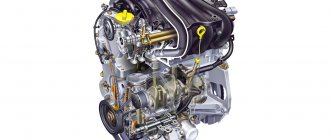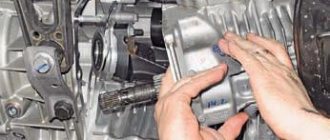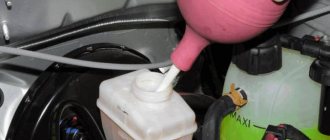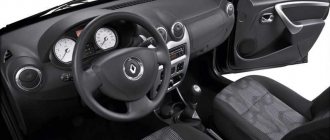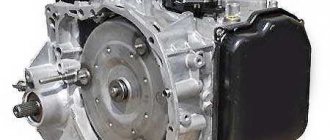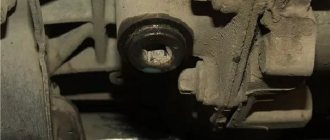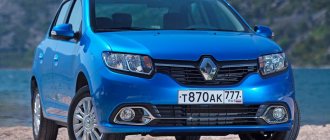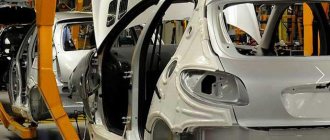Full or partial replacement
You can change the oil in the automatic transmission of a Renault Duster car completely or partially.
By complete we mean draining the old oil, flushing the crankcase and filling in new oil. A partial replacement involves gradually adding new oil as it mixes with the old one. This method is applicable for cars with mileage exceeding 100 thousand kilometers. The fact is that old oil creates deposits on the crankcase walls, which, when flushed, can clog small channels. All this leads to “oil starvation” and failure of the unit.
In a partial replacement, the old one is drained, and then the new one is poured in in the same quantity every 200-300 kilometers. It is not recommended to immediately pour a new one in place of the old one, since they may have completely different chemical compositions.
When and how to carry out a partial replacement
As mentioned earlier, partial is performed when the car’s mileage is already too high. To do this, you need to choose a high-quality lubricant, which the manufacturer recommends for Renault Duster automatic transmissions, and drain several hundred grams of old oil from the crankcase.
Exactly the same amount of new oil is poured. Now you need to drive about 200-300 kilometers on this mixture. As soon as the car has driven the required number of kilometers, you need to drain some of the old oil again, and then drive another 200 kilometers. This cycle is performed until the entire canister of new lubricant is filled into the crankcase.
Partial replacement is not only the only way to change the oil in the old gearbox, but also a good opportunity to flush the automatic transmission from heavy deposits. As you know, the best flushing agent is the oil itself, but it is very expensive. Therefore, it is not advisable to use it as a flush. It is best to buy the appropriate fluid or gradually change the composition of the lubricant.
It is not recommended to mix oils from two different manufacturers or different chemical compositions. For example, lubricant intended for winter operation of automatic transmissions cannot withstand high temperatures at all. This rule also applies in reverse. Therefore, it is best to make a complete replacement.
Complete replacement
If you want the gearbox to last for hundreds of thousands of kilometers, then it is recommended to completely change the automatic transmission oil on a Renault Duster car. If you do this procedure every 60 - 100 thousand kilometers, the unit will not only not require partial replacement, but will also last for a very long time. This procedure is performed as follows:
- The car is driven onto a lift or inspection hole.
- The brand of gear oil is specified and the required type is selected.
- The dipstick is pulled out and the car is raised to a height sufficient for replacement.
- Now you need to remove the Renault Duster engine protection, and then unscrew the oil drain plug and drain the oil into a suitable liquid. It should drain for at least 10 minutes. Finally, the plug is screwed into place and the car is lowered.
- Now unscrew the filler cap or bolt (depending on the gearbox modification) and pour flushing fluid into the automatic transmission. For Renault Duster, it makes no difference what kind of liquid it is. The most important thing is that it has a transmission.
- The filler cap closes and the engine starts. You need to let it idle in neutral gear for about 5-10 minutes. During this time, flushing cleans the mechanism of old oil residues and contaminants.
- Now drain the flush and fill with a new one. The principle of draining and filling is the same here.
It is not recommended to put too much load on new oil. It is necessary to gradually pick up speed and also smoothly reduce it so that the mechanism “gets used” to the new lubricant.
Main malfunctions and problems of the Duster automatic transmission
One way or another, even with all the improvements, the frequent problems characteristic of Renault-Nissan 4-speed automatic transmissions have not gone away. Shocks may appear during shifts, thoughtfulness remains, logic when choosing gears suffers, etc.
According to the manufacturer, the gearbox is maintenance-free, that is, the transmission oil in the Duster automatic transmission does not need to be changed. At the same time, automatic transmission repair specialists claim that changing the oil in the Duster automatic transmission is simply necessary every 40-50 thousand km. This approach will increase the service life of the unit, which is already not long (on average, about 150 thousand km).
Also, the automatic mode allows you to dampen the gas pedal for more accurate dosing of traction. So, when this mode is turned on, automatic transmission jerks often appear, and an error may light up on the panel. In this case, dealers offer flashing the control unit, although this does not always solve the problem.
Another problem with this machine is a problem with the solenoid valves in the valve body. Simply put, the TCC solenoids, which are responsible for blocking the gas turbine engine, as well as the EPC (line pressure) solenoids, often begin to malfunction. The only advantage can be considered their quick and inexpensive replacement.
Also, some owners note that there are cases where little oil was poured into the automatic transmission and transfer case at the factory. Antifreeze can also get into the oil due to problems with the sealing rings; in some cases, the automatic transmission oil regulator requires replacement.
As for overheating, the presence of an additional cooling radiator and a modified oil deflector solved a number of problems, but the machine can still fall into emergency mode due to overheating. The reason is contamination of the cooling radiator.
What are the advantages of a Duster with an automatic machine?
Popular reviews from owners of Renault Duster from 2.0 liters, automatic with photo
Renault Duster, if it has an automatic, it is well worth the money. Versions with automatic transmission and all-wheel drive system, which were released in our country before 2013, were very simple in their design and even in maintenance. Yes, and maintenance can be carried out much cheaper than it will cost for cars of direct competitors. The all-wheel drive automatic popular crossover is very economical. It is dynamic while driving and at the start. The driver can independently switch between four-wheel drive and single-wheel drive at any time.
Automatic transmission in Duster: what are the disadvantages
If you listen or read the reviews of the owners, the crossover from France Renault Duster consists not only of advantages, it also has disadvantages in its arsenal:
- The automatic transmission is somewhat sluggish when driving on the highway and shifting.
- Driving around the city is not very economical.
- At medium speeds, when switching speeds, strange noises and squeaks appear.
This car is still very popular in our country, despite such shortcomings.
Reviews
Based on experience, it is impossible to draw unambiguous conclusions from everything written, since if there are Renault Duster automatic reviews, they can be both positive and negative, so it is best to judge from personal experience and, based on this, draw a conclusion. Below is an example of several reviews:
- Evgeniy I was looking for a good car for the city for a long time, so it had to be a car with an automatic transmission, I visited many showrooms, and the choice fell on Duster and I signed up for a test drive. During the test drive, the crossover behaved briskly, the only thing I noticed was that gear shifting occurred with a slight delay, this was alarming at first glance, but the manager explained everything. Overall, I liked the car, so I chose it. I’ve owned it for a year now, I’ve been using it both in the city and in the countryside, no problems have arisen, so I’m very pleased with my purchase.
- Mikhail When purchasing a car, he relied primarily on technical characteristics, and not on appearance, so the choice fell on this model with automatic transmission. As for repairs, the prices for spare parts are quite affordable. Having traveled all over Russia, the crossover has never let us down; it behaves perfectly both on the highway and in complete off-road conditions. Of course, there are some minor drawbacks, such as the interior design, but when choosing this model, I relied primarily on practicality and reliability.
Renault Duster - technical characteristics of Renault Duster
| Body type | SUV | ||
| Number of doors | 5 | ||
| Length | 4315 | ||
| Width | 1822/2000 | ||
| Height | 1625 | ||
| Wheelbase | 2673 | ||
| Fuel tank (l) | 50 | ||
| Turning diameter (m) | 10,4/10,7 | ||
| Tire size | 215/65 R 16 | ||
| Front brakes: discs (mm) | 280 | ||
| Rear brakes | Drums (9") | ||
| Engine | 1.6 16v | 1.5 dCi | 2.0 16v |
| Toxicity standards | 185 | 140 | 185 |
| Cylinder displacement (cm3) | 1598 | 1461 | 1998 |
| Number of cylinders | 4 | 4 | 4 |
| Number of valves | 16 | 8 | 16 |
| Maximum power, kW (hp) | 75 ( 102) | 066 (090) | 99 ( 135) |
| Maximum torque (N.m) | 145 | 200 | 195 |
| Injection type | Distributed injection | Common Rail | Distributed injection |
| Fuel | Petrol | Diesel | Petrol |
| Gearbox type | MCP | MCP | automatic transmission |
| Number of gears | 6 | 6 | 4 |
| Urban cycle (l/100km) | 11,0 | 5,9 | 11,0 |
| Extra-urban cycle (l/100km) | 7,0 | 5,0 | 6,7 |
| Combined cycle (l/100km) | 8,2 | 5,3 | 8,3 |
| Maximum speed (km/h) | 158 | 156 | 168 |
| Acceleration time 0-100 km/h(s) | 13,5 | 15,6 | 11,2 |
| Maximum trunk volume (l) | 1570 | 1570 | 1636 |
| Minimum trunk volume (l) | 408 | 408 | 475 |
| Clearance | 210 | 210 | 205 |
| Curb vehicle weight | 1393 | 1450 | 1374 |
| Maximum permissible weight | 1818 | 1875 | 1799 |
| Full mass | — | — | — |
| Payload | 425 | 425 | 425 |
| Maximum permissible towed trailer weight with brake system | 1500 | 1500 | 1200 |
| Maximum permissible towed trailer weight without brake system | 695 | 725 | 685 |
Review of Renault Duster 2021 model year
Technical characteristics of the automatic transmission
The gear ratios in the automatic transmission are selected so that the Renault Duster crossover can reach a speed of 174 km/h. Acceleration time to 100 km/h is 15.5 seconds.
The characteristics of the four-speed automatic transmission are similar to the six-speed manual transmission. However, the latter is not equipped with a gearbox that transmits torque through the driveshaft.
Gasoline consumption will be 11.6 liters in the city, 7.4 liters on the highway. In mixed mode, 8.7 liters are consumed.
The gear ratios were set as follows:
- 1 speed – 2.727;
- 2 – 1,499;
- 3 – 1,0;
- 4 – 0,711;
- reverse gear - 2.457.
LET'S GO! —
12 best tires for Renault Duster
heard one of the authors in response to the thoughtful reasoning outlined above. - All this is correct, but now take this trunk and take it to that Duster over there! When, instead of the usual foreign test drive, Za Rulem offered to take part in driving the car to Moscow, doubts arose only about the choice of route. In order to be on time with the material for this issue, I had to abandon the idea of coming to Russia in a Duster. We preferred one and a half thousand kilometers of Spanish-French highways and a small but indicative part of the prairies... or whatever they call it, where you drive off the asphalt.
Another sign is on the parting panel: the symbols D and 4WD LOCK.
Another sign is on the parting panel: the symbols D and 4WD LOCK.
Another sign is on the instrument panel: symbols D and 4WD LOCK
To say that the all-wheel drive Duster with an automatic transmission immediately stands out against the background of its front-wheel drive older brother is to sin against the truth. Set the mode to 2WD - and here you have the same car. Go and feel how much the gear ratios in the transmission have been changed (answer: increased by about 5%).
By the end of the second day, consumption measured at 10.2 l/100 km at an average speed of 72.9 km/h. It could have been smaller, but for this the “automatic” lacks a couple of steps. “Duster” is by no means a testing ground for new technical solutions; it tries on time-tested (read: inexpensive) units.
The trunk of the 4x4 version is 67 liters smaller because it has a higher raised floor. But the spare tire is placed directly under it, and not fastened outside in the rear overhang. Getting it out of there, much less putting it away, is a dubious pleasure.
The trunk of the 4x4 version is 67 liters smaller because it has a higher raised floor. But the spare tire is placed directly under it, and not fastened outside in the rear overhang. Getting it out of there, much less putting it away, is a dubious pleasure.
The trunk of the 4x4 version is 67 liters smaller because it has a higher raised floor. But the spare tire is placed directly under it, and not fastened outside in the rear overhang. Getting it out of there, much less putting it away, is a dubious pleasure.
When overtaking, the automatic transmission decisively shifts to a downshift, forcing the engine to howl in an attempt to accelerate the car. Alas, its efforts are lost somewhere between third and fourth gears, so the sluggish advance doesn't match the noise effects at all. This is where you should look at the speedometer and make sure that 120 is not your pace with the Duster. To be fair, in the Russian speed range overtaking is much more dignified.
Renault Duster manual transmission repair services
The procedure for repair work, the price, and the time the car stays in the workshop depend on the type of breakdown and the type of repair that will be required (local or major).
When accepting a car, we perform the following cycle of operations:
- Consultation. The first communication with the car owner can take place over the phone or directly in the workshop. We will listen to complaints and find out what deviations from the norm occurred in the operation of the car.
- Diagnostics. Using diagnostic devices with licensed software, we will identify the sources of problems. They may consist of a worn clutch, failure of the flywheel, bearings, defects in the gear shift mechanism or other components.
- Troubleshooting. At this stage, the Duster box is removed and disassembled. The craftsmen wash the parts and determine how damaged and worn they are. Determine whether they can be restored or require replacement.
- Renault Duster manual transmission repair, assembly, installation. After identifying the causes of malfunctions, we begin to eliminate them, change spare parts, assemble the entire mechanism and install it on the vehicle.
- Control diagnostics are carried out to monitor the quality of the result and eliminate defects if they appear. The inspection ends with a test car rental.
- Service. After repair, the transmission fluid must be changed. Subsequently, this procedure and intermediate diagnostics must be performed periodically, after 80-100 thousand km. Timely inspection and prevention make it possible to postpone the repair of the Renault Duster gearbox for a long time.
- Price calculation. The cost will depend on what type of gearbox is on your Renault Duster; the box can be 5- or 6-speed, new, with minor defects or in critically worn condition. Therefore, we will announce the exact amount after the troubleshooting. Preliminary prices can be viewed on the website or obtained from a specialist during a consultation.
Transmission of the new Renault Duster, gearbox, 4x4 drive
As for the transmission of the new Renault Duster, it is unlikely that significant changes will be made to the mechanical transmission options. But something needs to be done with the ancient 4-band automatic transmission. Most likely, it will finally be discontinued and a continuously variable CVT will appear on the new version of the crossover. Moreover, Renault engineers have experience using such a box with a base engine. Suffice it to recall the Renault Kaptur, built on the same platform as the Duster.
True, judging by the official information from the manufacturer, the main focus is on robotic EDC machines. The truth is whether European robotic transmissions will reach our market remains unknown.
The all-wheel drive system on the second generation will not receive fundamental changes. A transversely mounted motor, a gearbox with an additional gearbox for transmitting torque to the rear gearbox and, of course, an electromagnetic clutch, which allows you to turn a front-wheel drive car into a 4x4 all-wheel drive with one press of a button/turn of a washer.
Renault Duster all-wheel drive operation diagram
The so-called bevel gearbox (or front gearbox) has compact dimensions and is easily installed on a manual or automatic transmission. Its task is to transmit torque to the rear axle. It all looks something like this. Let's look at the picture below.
In fact, it is the front and rear gearboxes that are the main elements of the Duster all-wheel drive transmission.
The most important element of the entire transmission of this type is the electromagnetic clutch. In principle, the cardan transmission coming from the front of the crossover always rotates backwards, but the torque is not always transmitted to the rear gearbox.
It's all about the Duster clutch, which serves as a connecting unit and transmits torque as required by the electronics. The clutch consists of an electromagnet, a cam mechanism and an electronic control unit. An increase in voltage causes electromagnets to operate, which attract the clutches simply by clamping them. This traction force is quite enough to transmit torque to the rear gearbox, and from there to the rear wheels. If the control unit supplies insufficient voltage to the electromagnet, the Renault Duster clutch will provide a partial circuit.
In automatic mode, when the front wheels turn without much load (for example on ice), part of the torque is transmitted to the rear wheels, ensuring stability when driving. This design also has one drawback: overheating of the electromagnetic clutch, which can occur due to the high friction force of the clutches. That is why it is not allowed to drive at high speed in the “Lock” all-wheel drive mode. In most cases, the electronics automatically disables the clutch based on ABS sensors and other parameters.
Most likely, for greater reliability of all-wheel drive, on the new generation Renault Duster, engineers will provide better cooling of the unit and install a temperature sensor that turns off the clutch if it overheats. After all, until now there is simply no such sensor on a budget crossover, which increases the risk of overheating/destruction of the clutches.
By the way, the transmission mode switch itself for the new Duster 2021 model year has moved from the center console to the gearbox tunnel between the seats. Look carefully at the photo just above. Now it is a large and nice washer located behind the gear lever.
HOW MUCH? —
“Duster” allows you to ask this question in the right tone, still pleasantly surprising with a reasonable price. “Automatic” will cost exactly 38,000 rubles, if you compare identical configurations (details in the table).
We drove from Madrid to Paris in the most expensive car, to the base price of which is 775 thousand (Lux Privilege version) we will add another eight thousand for metallic, ten for navigation (by the way, I really liked it, only the screen is too low), 13 thousand for ESP. Total 806,000 rubles.
The most expensive Duster in Spain costs exactly the same - 18,000 euros. The equipment is similar to ours, with a 110-horsepower diesel engine under the hood. Only he does not and cannot have an “automatic machine”...
We couldn’t help but take a photo of a tram in the center of Bordeaux, which, for aesthetic reasons, collects current from the third rail. Only the section of track under the tram is powered. 02. 2014 Behind the wheel 31,028
We couldn’t help but take a photo of a tram in the center of Bordeaux, which, for aesthetic reasons, collects current from the third rail. Only the section of track under the tram is powered. 02. 2014 Behind the wheel 31,028
We couldn’t help but take a photo of a tram in the center of Bordeaux, which, for aesthetic reasons, collects current from the third rail. Only the section of track under the tram is powered
Automatic transmission Renault Duster 4x4, 2.0
Duster automatic transmission is available in two types, each of which has 4 gears. One is designed for front-wheel drive vehicles, the other for all-wheel drive vehicles. Previously, for a long time, it was impossible to buy an all-wheel drive Renault Duster with an automatic transmission - they were not produced. This can be explained simply - the Duster received an automatic transmission of the DP2 type, which was installed on front-wheel drive Renault Logan and Renault Sandero.
The gearbox received minor changes, but, nevertheless, could only be installed on a car with front-wheel drive. A version of the Duster automatic transmission for an all-wheel drive crossover was released relatively recently, and, despite this, it quickly gained recognition among car enthusiasts.
Duster 4x4 automatic transmission
The new Duster automatic transmission is called DP8. It is not much different from the DP2 version of the automatic transmission designed for front-wheel drive Duster cars. The main difference is the gearbox, which transmits torque to the rear wheels of the car. In terms of dynamics, the all-wheel drive Renault Duster is practically no different from the 4x2 Duster, but requires higher fuel consumption.
The Duster automatic transmission provides a quick and smooth start. In this case, for example, at a speed of 60 km/h it will no longer be possible to accelerate quickly. Due to the fact that the Duster automatic gearbox has only 4 gears, fuel consumption is quite high.
Duster 2.0 automatic transmission
The Renault Duster 2.0 automatic transmission performs well both when driving around the city and when driving in off-road conditions. This modification is perfect for owners of dachas and country houses who are looking for a reliable and inexpensive car. The Duster travels well through snow, mud and swamps, accelerates quickly and quite easily adapts to the driving style of the car owner. At the same time, the car has increased fuel consumption. The engine is not particularly dynamic and is more suitable for those who like a quiet ride.
Characteristics of automatic transmission Duster:
- Acceleration to speed of 100 km/h in 11.7 seconds.
- Max. speed 172 km/h
- Fuel consumption, city: 11.3 l
- Fuel consumption, highway: 7.2 l
- Fuel consumption, mixed: 8.7 l
Most car owners note that a Duster with an automatic transmission has increased fuel consumption. This is partly due to the characteristics of automatic transmissions, and partly due to the fact that the car has only 4 gears.
In addition, many Duster owners say that the automatic transmission works “lazily.” And despite this, it provides a high level of comfort while driving and literally adapts to the driver and his driving style.
There is also an opinion that the Duster automatic transmission is less reliable and durable compared to a manual transmission. In 2013, AutoReview published the results of a long-term test of the DP2 gearbox installed on a Nissan Almera. According to test results, after 27 thousand kilometers, which corresponds to 80 thousand kilometers under normal conditions, the automatic transmission failed. The cause was overheating as a result of severe slipping of the clutches. Considering that DP8 is based on DP2 and is not very different from the latter, we can assume that it has approximately the same service life.
Repairing a Duster automatic transmission will cost about 250 thousand rubles. in the official service. However, it should be borne in mind that during the test the car is subjected to a very intense load, which is hardly comparable to normal operating conditions. Therefore, the risk that the automatic transmission of a Renault Duster car will fail after 80 thousand kilometers is very unlikely.
Duster automatic transmission problems:
- Increased fuel consumption
- Slow response
- Fragility
- Expensive repairs
Duster automatic transmission, like the gearboxes of many other cars, has its advantages and disadvantages. If you are looking for comfortable handling and a smooth ride, then this equipment is suitable for you. If the efficiency of the car is important to you and you are categorically not satisfied with excessive fuel consumption, the best solution would be to take a closer look at the version with a manual transmission.
Robot box for Renault Duster
Another version of the Duster with automatic transmission is the Renault Duster EDC, released in 2021. Unlike its predecessors, this is no longer a “classic” automatic, but a robotic gearbox. Renault Duster with a robot received an Efficient Dual Clutch (EDC) robotic gearbox with two clutches (similar to the updated Renault Captur, etc.)
For the Renault Duster, such a box is available exclusively with a 1.5-liter turbodiesel engine producing 110 hp, as well as in a front-wheel drive version. The EDC gearbox on the Duster changes gears rather harshly (especially the transition from 1st to 2nd), there are slight dips and delays when the gas pedal is sharply pressed.
However, in the case of smooth driving, the robot shifts almost imperceptibly both up and down, keeping the diesel engine speed in the maximum torque range.
A manual semi-automatic mode is also available, in which the driver can change gears independently. At the same time, recommendations are displayed on the instrument panel when it is better to change gear.
The robot also “forgives” mistakes, preventing the driver from shifting to a gear that is too high or low, taking into account the inappropriate speed of the vehicle. The transmission will also switch to lower gears when you press the gas pedal hard and activate the kick-down mode.
Also, the version with the robot received a hill start assist system, which helps avoid rolling back when starting off. Fuel consumption for the Duster EDS is stated to be even lower than for the “mechanics”. If you don’t look at the passport data, in practice, even with active driving, a car with such an engine and gearbox consumes only 6.5 liters of diesel per 100 km. around town.
As for the shortcomings, there are no clear statistics on the model yet, taking into account its novelty. In a number of cases, rapid wear of the clutch packs has been noted, however, such breakdowns are rare and are repaired under warranty. Further problems will only appear over time, as is the case with any other car that has recently entered the market.
Let's sum it up
Based on numerous reviews from owners, the Renault Duster 4x4 provides many opportunities that are not available to the owner of an SUV. Knowing the principle and operating modes of the clutch of a car version with an all-wheel drive system, you can achieve comfortable off-road driving and at the same time dynamic trips in city traffic jams and highways, without worrying about high fuel consumption and the need for frequent transmission repairs.
Crossovers are a relatively new class that have become incredibly popular in many countries over the past 10 years. This success did not bypass Russia either - according to statistics, crossovers have become more popular here than C-class sedans, although 5 years ago it was difficult to even imagine this. Actually, the success is natural: for relatively little money you can buy a comfortable and functional car with high clearance, which is convenient to move both around the city (“I sit high, I can look far away”) and outside the city, especially if you have a dacha or a country house.
The first crossovers mostly had all-wheel drive. And only Americans were offered crossovers with single-axle drive. In our country, at first, such cars were almost never offered - why would our people need a “jeep” without all-wheel drive? Today everything has changed and the vast majority of SUVs are sold with only one axle drive, since it is cheaper, and all-wheel drive is rarely required for city driving.
Renault Duster is offered with two types of drive: only on the front axle and on all four wheels. Whether it's worth buying the all-wheel drive version is up to you to decide. But if you have housing outside the city where there are no asphalt roads, then most likely you should choose the all-wheel drive version.
How does all-wheel drive work?
The Renault Duster uses an all-wheel drive transmission similar to that found on cars such as the Nissan X-trail and Qashqai (both companies are part of the same concern).
To control transmission modes, a special switch is used, which can be found on the front panel. There are three modes in total:
The 2WD mode involves driving only in front-wheel drive, while the driveshaft, which should transmit torque to the rear gearbox, rotates idle. This is the most optimal mode for road driving.
In AUTO mode, the front wheels are still driven, but in this case the electronics decide when the rear axle can be engaged. For example, an electromagnetic clutch can be activated if the drive wheels begin to slip. Torque can be distributed from a ratio of 100:0 to 50:50 from the front to the rear axle. This mode is often used, for example, on snowy country roads.
By switching the washer-switch to LOCK mode, the driver completely closes the clutch and now all-wheel drive is always connected. True, it only works at speeds up to 40 km per hour, after which it automatically switches to AUTO mode. This was done for a reason, but to ensure that the transmission does not overheat, since overheating can lead to its breakdown. The mode is usually used for driving on sand, mud or snow at low speed.
In principle, nothing complicated - a system similar in operation is available on many all-wheel drive vehicles. The Renault Duster AWD (4x4) is offered with both automatic and manual transmission, the latter being exclusively a six-speed unit (the 4x2 version is also offered with a 5-speed gearbox).
And further. When using all-wheel drive it increases. Besides,
When it comes to a crossover (a fashionable topic!), they certainly say that it must be not only universal and with high ground clearance (compared to conventional cars), but also all-wheel drive. Even if the car is the most urban, its owner never leaves the asphalt. Single-wheel drive versions are usually supplied only in the most inexpensive trim levels, and they are rarely kept in press parks. Maybe in vain? After all, if we discard the indisputable pros of four driven wheels - cross-country ability (mainly on loose snow) and acceleration abilities (in the same conditions), what else can be considered as advantages? Moreover, perhaps on asphalt the difference in weight and friction losses will allow you to drive more economically? Or maybe safer?
Renault Duster: automatic or manual transmission, comparison and conclusions
Renault Duster gearbox
The Renault Duster crossover is one of the best-selling vehicles, produced in the Russian Federation and equipped with automatic and manual transmissions. When purchasing Duster, you can choose from:
A universal 5-speed manual transmission can be installed on front-wheel drive Dusters with 1.6 or 2.0 liter gasoline engines.
MK6 is designed for diesel models and gasoline all-wheel drive with a 2.0 engine. The automatic transmission can only be installed on all-wheel drive Renault with a two-liter engine.
The Duster uses a classic JR5 twin-shaft gearbox for front-wheel drive cars with five forward gears and one rear. All mechanics are enclosed in an aluminum case. Communication with the atmosphere occurs through a breather located in the upper part of the unit.
The gearbox conveys the dynamics of the Renault car well in urban conditions and on the highways. The gears are controlled by levers, so vibration can be transmitted to the gearshift knob.
The Renault TL8 six-speed manual transmission is distinguished by the fact that it has a cable-driven gearshift and does not transmit vibration to the handle. The manual transmission is somewhat more complicated, with an increased number of gears, and the fact that it transmits torque not only to the front wheels, but also to the rear wheels as needed. Renault's rear-wheel drive is normally disabled, but the mechanism constantly transmits torque to the cardan. As soon as the front wheels begin to slip, the electromagnetic clutch located in the rear gearbox engages the rear drive.
Due to the fact that Duster does not have a transfer case in the full sense of the term, Renault engineers decided to recalculate the gear ratios of the mechanical gears so that the first one becomes reduced. Therefore, in normal road conditions, it is customary to start driving a Duster at second speed.
Gear ratio:
The Duster's four-speed DP 8 automatic transmission is connected in the same way as the manual gearbox. In this regard they are identical. The Duster automatic differs from other similar Renault cars by its impeccably selected gear ratios:
The Renault automatic was designed specifically for the Russian Duster on the basis of a front-wheel drive automatic. Since the load on the mechanism increased, so that it did not overheat, an additional cooling circuit was connected to it and the gear ratios were changed.
Automatic transmissions are gradually replacing manual ones. The older generation complains about unreliability, the younger generation wants to ride comfortably. Today we can safely say that automatic transmissions have equaled the quality of manual transmissions. This is evidenced by the fact that when buying cars in 2021, future car owners in 60% of cases preferred to choose cars with an automatic transmission.
Of course, an automatic transmission is more convenient than a manual transmission and is almost as good in dynamics, but if you like to drive economically, you should know that an automatic transmission adds at least 10-15% to the normal consumption.
Features of the new DP8 unit
The Duster gearbox is a modernized automatic transmission from Logan or Sandero, manufactured by Renault. It had to be strengthened somewhat, because the Logan is slightly weaker in power, and the cylinder volume is only 1.6 liters versus the Duster’s 2.0 liters.
According to reviews, there is not much difference between them in management.
A modification of the DP8 automatic transmission was developed by French and Russian engineers from the Renault concern. According to reviews from owners, the main drawback of its predecessor DP2 was slipping of the clutches while overcoming snow and mud obstacles, which caused the machine to get hot. Obviously, in a four-wheel drive vehicle the overheating would be much worse. Therefore, the developers installed an additional cooling circuit on the speed switching device and increased the gear ratio of the main pair. The control program was also adjusted.
The configuration of a 2-liter engine with all-wheel drive and an automatic transmission is quite a gluttonous combination, so Renault engineers installed a new automatic valve timing control system on the engine. Which, according to reviews, after 30,000 km requires additional tuning.
But in the reviews, the owners did not note this.


